Hmmmm, thats teh rpoblem with Japan. At least in youre Germany game, you could ignore the fleet for some time. Hopefully you'll win the battle.
The Setting Sun - Gotterdammerung, Japan 1944.
- Thread starter unmerged(59906)
- Start date
-
We have updated our Community Code of Conduct. Please read through the new rules for the forum that are an integral part of Paradox Interactive’s User Agreement.
You are using an out of date browser. It may not display this or other websites correctly.
You should upgrade or use an alternative browser.
You should upgrade or use an alternative browser.
Manziel, Chipseal, thatguy, Sokraates - We shall see 
germanpeon - They are too far away to receive their new pennants so are still using their German ones until they reach a Japanese port.
Romanius, Panzer6 - You are correct that Germany is not so difficult. Panzer6 is correct in that the Soviets are a peaceful nation, for now.
String Theory, Nathan Madien, Reado - Fortunately it was none of those far superior navies
Deus - Thank you. India is just a side show of course.
Murmurandus - What cliffhanger? I can go lower yet I think
Thurak - 5 stars is not too easy with a ship but I can try I guess
Lord Strange - The way I look at it that the naval war has to be fought at some point. Its easier to do it now than having to wait several years to build a new fleet.
Update to follow ...
germanpeon - They are too far away to receive their new pennants so are still using their German ones until they reach a Japanese port.
Romanius, Panzer6 - You are correct that Germany is not so difficult. Panzer6 is correct in that the Soviets are a peaceful nation, for now.
String Theory, Nathan Madien, Reado - Fortunately it was none of those far superior navies
Deus - Thank you. India is just a side show of course.
Murmurandus - What cliffhanger? I can go lower yet I think
Thurak - 5 stars is not too easy with a ship but I can try I guess
Lord Strange - The way I look at it that the naval war has to be fought at some point. Its easier to do it now than having to wait several years to build a new fleet.
Update to follow ...
Operation Dilemma
13
13
0600 February 14th 1945.
Carrier Group C Flagship. IJN Zuikaku, Gulf of Khambhat.
Admiral Nagano was looking at his maps to plot his fleets new course away from western India when there was a knock on his cabin door.
"Come in." he said.
"Admiral you are needed on the bridge immediately." a heavy breathing messenger informed him.
Nagano laid down his dividers and allowed the messenger to lead him to the bridge of IJN Zuikaku as he considered why he would be needed so urgently.
The sudden sound of the alarm for Action Stations was not unexpected as there was an enemy fleet heading their way from Bombay. This could just be normal. Nagano thought otherwise. Something was definately not right.
Arriving on the bridge he knew he had been correct. This much activity was not normal for an airstrike against a small sized Transport fleet. Judging from the action around him IJN Zuikaku was already turned into the wind and looked to be preparing to launch just about every single aircraft at her disposal. That only happened for one reason.
"Enemy Carriers?" he asked Captain Notomo.
"Yes Admiral, at least four." Notomo replied with a certain degree of concern.
"There is something else Captain?"
"Five Battleships and a similar number of Heavy Cruisers."
"I think we might want to keep them as far away as possible. Lets start opening the distance between them and us before this gets even uglier than it already is." Nagano ordered.
"Come in." he said.
"Admiral you are needed on the bridge immediately." a heavy breathing messenger informed him.
Nagano laid down his dividers and allowed the messenger to lead him to the bridge of IJN Zuikaku as he considered why he would be needed so urgently.
The sudden sound of the alarm for Action Stations was not unexpected as there was an enemy fleet heading their way from Bombay. This could just be normal. Nagano thought otherwise. Something was definately not right.
Arriving on the bridge he knew he had been correct. This much activity was not normal for an airstrike against a small sized Transport fleet. Judging from the action around him IJN Zuikaku was already turned into the wind and looked to be preparing to launch just about every single aircraft at her disposal. That only happened for one reason.
"Enemy Carriers?" he asked Captain Notomo.
"Yes Admiral, at least four." Notomo replied with a certain degree of concern.
"There is something else Captain?"
"Five Battleships and a similar number of Heavy Cruisers."
"I think we might want to keep them as far away as possible. Lets start opening the distance between them and us before this gets even uglier than it already is." Nagano ordered.

Carrier Group C's eight Aircraft Carriers would face the four more modern British Carriers, led by HMS Victorius and commanded by Admiral Fraser. The two Carrier fleets were of equal size but Nagano had to try and protect a Transport fleet, which would severely limit his options.
Luckily the British fleet was extremely top heavy. There were a mere three escort ships to protect the Carriers and Battleships which would place similar constraints upon Fraser.
Had this battle occurred without the Transports in tow Nagano would be confident of a decisive victory, as it was he would settle for keeping his fleet in tact.
Luckily the British fleet was extremely top heavy. There were a mere three escort ships to protect the Carriers and Battleships which would place similar constraints upon Fraser.
Had this battle occurred without the Transports in tow Nagano would be confident of a decisive victory, as it was he would settle for keeping his fleet in tact.

Four British Submarines had arrived late to the battle and bolstered Fraser's numbers to twenty but these just placed even more strain on the escorts. The battle was almost totally inconclusive as the range remained outside of the enemy big guns and both Admirals seemed more concerned with protection than causing damage.
Only one ship was sunk, unfortunately Japanese, the Transport Flotilla 9 Yuso Sentai. Several Carriers had been damaged but none critically when Fraser opened the range far enough to escape north.
Much to Nagano's surprise Yamamoto ordered him to pursue the enemy fleet while the Transports of Godo headed towards Colombo.
Only one ship was sunk, unfortunately Japanese, the Transport Flotilla 9 Yuso Sentai. Several Carriers had been damaged but none critically when Fraser opened the range far enough to escape north.
Much to Nagano's surprise Yamamoto ordered him to pursue the enemy fleet while the Transports of Godo headed towards Colombo.

The British Battleship fleet that had been sighted around Indonesia was re-acquired at 0100 hours on the 15th. It had altered course and was now heading west towards southern India. There was a chance that it was after the Aircraft Carriers but that could not be confirmed.
Yamamoto was now trying to keep track of two Battleship fleets, one British and one American, as well as two Carrier Fleets, one British and one French. All four of these fleets could be converging on the Indian Ocean, which would mean that the Imperial Japanese Navy would be leaving if it was the case.
The next message to arrive, at 0300 hours, was fairly urgent and from Lt. General Yokoyama Isa. He had a problem, a much more serious one than was normal. The American's had learnt how to try and invade.
Yamamoto was now trying to keep track of two Battleship fleets, one British and one American, as well as two Carrier Fleets, one British and one French. All four of these fleets could be converging on the Indian Ocean, which would mean that the Imperial Japanese Navy would be leaving if it was the case.
The next message to arrive, at 0300 hours, was fairly urgent and from Lt. General Yokoyama Isa. He had a problem, a much more serious one than was normal. The American's had learnt how to try and invade.
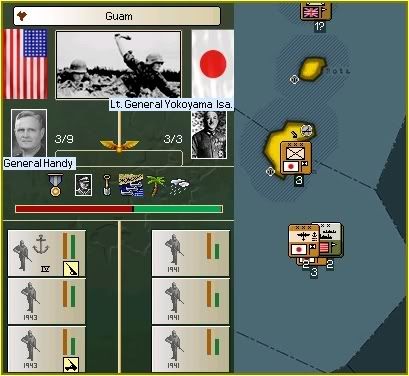
This time there were no tanks. Properly led marines and infantry were the exact thing that Yamamoto did not want to see trying to take Guam. He had no idea if there were any escorts for the invading fleet but the lack of Gunfire Support made it unlikely. There was some chance that the American's could win this battle, although Genda was already on the scene with his bombers.
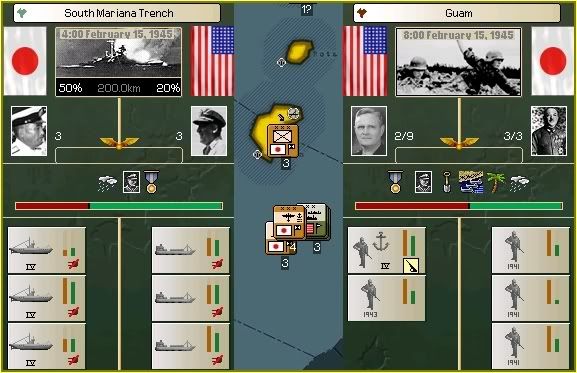
The Submarines in the area had reacted quickly and were closing on the transport ships within an hour. The arrival of Ozawa with his bombers made things look even better and by 0800 hours one of the Transport Divisions had been sunk along with its infantry division.
The battle ended shortly afterwards with the Submarines chasing the enemy ships away. Even three defending divisions might not be enough for these islands.
Carrier Group C had failed to beat the enemy Carrier Task Force to the Mouths of the Indus but they knew where the enemy fleet was.
The battle ended shortly afterwards with the Submarines chasing the enemy ships away. Even three defending divisions might not be enough for these islands.
Carrier Group C had failed to beat the enemy Carrier Task Force to the Mouths of the Indus but they knew where the enemy fleet was.

At 1200 hours Japanese aircraft took off and headed for the harbour of Rajkot to try and inflict more damage to the enemy fleet.
Only one ship would be sunk, the 6th Submarine Flotilla, falling to aircraft from IJN Junyo. The British carrier HMS Indomitable managed to survive the raid but only just. Several other ships received damage but nothing major as Nagano ordered his fleet away from the area, before a second enemy fleet could close with his own.
Yamamoto was fairly sure that the current situation throughout the Pacific was more or less back under control when he received another urgent message. Ozawa was not someone who cried wolf and if he said it was urgent it usually was.
Only one ship would be sunk, the 6th Submarine Flotilla, falling to aircraft from IJN Junyo. The British carrier HMS Indomitable managed to survive the raid but only just. Several other ships received damage but nothing major as Nagano ordered his fleet away from the area, before a second enemy fleet could close with his own.
Yamamoto was fairly sure that the current situation throughout the Pacific was more or less back under control when he received another urgent message. Ozawa was not someone who cried wolf and if he said it was urgent it usually was.
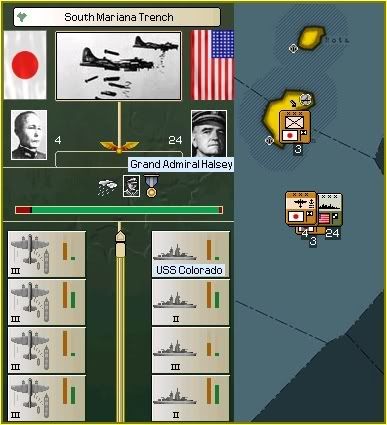
Admiral Halsey had brought his Battleship fleet to the Mariana Trench at 0800 hours on February 16th, led by the USS Colorado. Should the Transport fleets return with this fleet to guard them Guam would be in serious trouble. Halsey's fleet was still showing signs of earlier tangles with Japanese Naval bombers as Ozawa and Genda tried to inflict enough damage to make the hostile fleet leave. They only had two hours until nightfall which was not enough to inflict any serious harm.
A new day would see Halsey regret not leaving immediately after being spotted.
A new day would see Halsey regret not leaving immediately after being spotted.
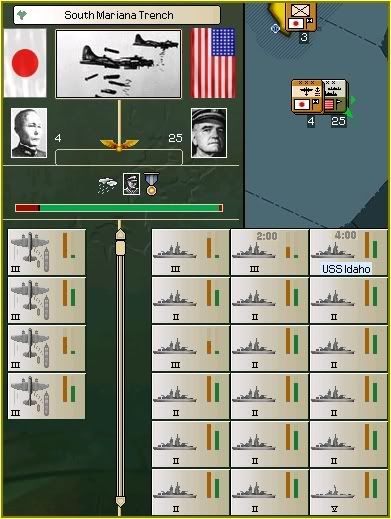
Ozawa returned at 2300 hours with the Submarines already safely in port. By 0200 hours the Battleship USS Maryland, which had been the most damaged ship prior to the bombing run, had been sunk and the Japanese bombers switched targets to the USS Colorado.
The crew of the USS Idaho plucked Admiral Halsey from the waters of the South Mariana Trench as orders were given to head south east, away from the destruction from above. The USS Colorado had only lasted two hours under the heavy bombardment from Ozawa and Genda.
The crew of the USS Idaho plucked Admiral Halsey from the waters of the South Mariana Trench as orders were given to head south east, away from the destruction from above. The USS Colorado had only lasted two hours under the heavy bombardment from Ozawa and Genda.
0000 February 17th 1945.
Intelligence Offices. Tokyo, Japan.
Kuniaki was given the latest update on current research projects which included the completion of improved Doctrine for ground forces.

Hisaichi Terauchi had finished Central Planning Doctrine and Kuniaki ordered him to continue along his research path and look into Infiltration in Depth, which would actually give Japanese an advantage under some circumstances, most notably night fighting.
0200 February 17th 1945.
North China Army Headquarters. Hinghong, China.
Higashikuni had found something for his Tactical bombers to do in India that would not require them to waste their bombs.
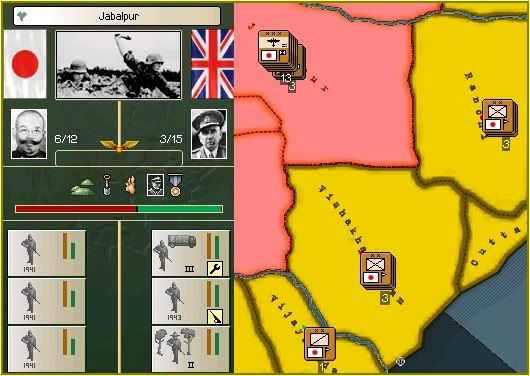
General Kawabe led an attack against Jabalpur which would allow the bombers to wreak havoc behind the defenders front lines. After a brutal battle lasting over twenty four hours the British defenders managed to valiantly hold on and repulse the attack. Unlike the Japanese troops they would not have the luxury of reorganising after the battle as the bombers kept harassing them.
At 1400 hours on the 17th a change in command in the British forces brought about another attack.

Field Marshal Alexander had taken over from Wilson in Kra and he had decided to try the defences of General Asaka in Singora. Asaka had not allowed Wilson to take his position and he would also deny Alexander.
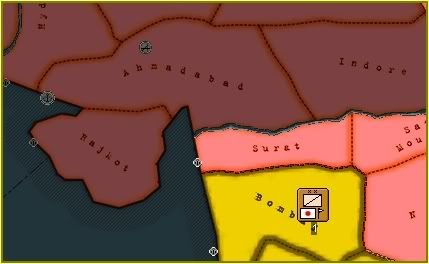
At 2300 hours on February 17th British forces re-occupied Ahmadabad.
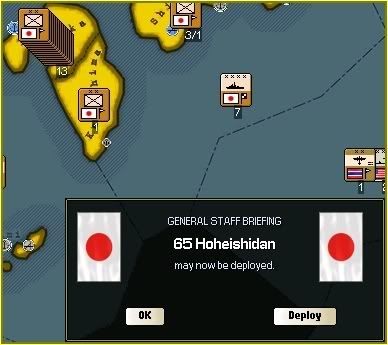
One hour later Higashikuni received news that the first new infantry divisions had been raised. Twelve new divisions deployed to Fukuoka to organise themselves before being found other more gainful employment. Three more would arrive the next day.
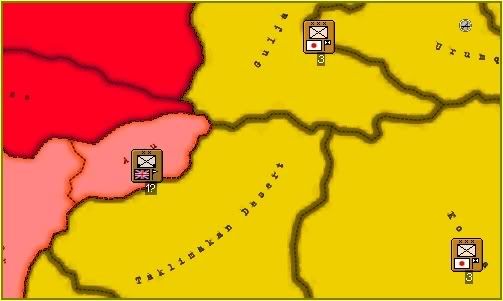
At 0300 hours on the 19th British troops finally arrived in Aksu province in north western China. General Anami's troops looked at the exhausted troops facing them and expected the order to attack. It never came. The British were welcome to the province, it was of no real use to Japan.
0300 February 19th 1945.
BB Division 1 Flagship. IJN Yamashiro, Gulf of Martapan.
Admiral Reeves and his smaller Battleship fleet had managed to cross the patrol path of a Japanese interceptor.
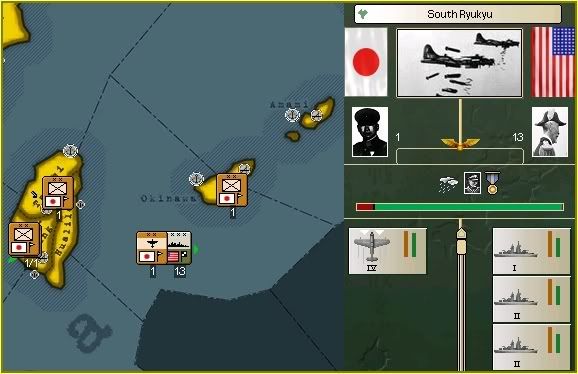
He was spotted south of Okinawa heading east. All Japanese vessels at sea in this area were ordered into port for the time being.
0500 February 19th 1945.
North China Army Headquarters. Jinghong, China.
General Kawabe's forces had been given twenty four hours to rest by HIgashikuni before they were ordered forward again.
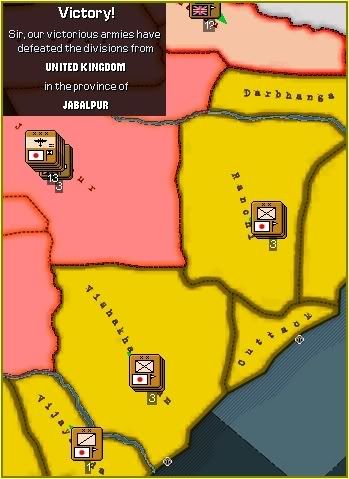
This time they would win the battle for Jabalpur almost instantaneously. The constant pressure from the bombers had given the enemy no chance to recover from the previous battle. Kawabe would rest a little while longer before actually advancing.

More good news followed as Field Marshal Hata re-occupied Phitsanulok. The British didn't even try a minor counter attack. The defences of Siam were looking solid once again.
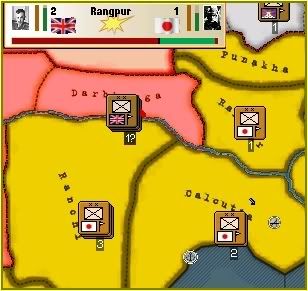
Good news was followed by bad as British troops captured Darbhanga and immediately assaulted Rangpur. They won this battle as well and were beginning to threaten to isolate Japanese forces in India from those elsewhere. They were operating outside of their own aircrafts protection, which would be a big problem once they arrived in Rangpur.
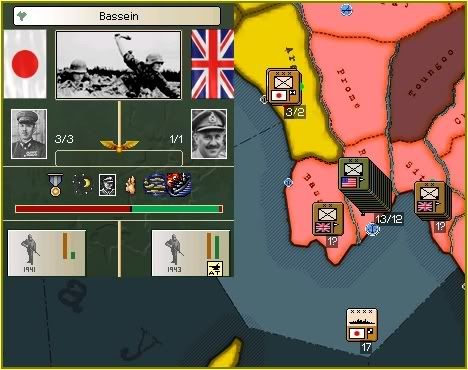
A British division had arrived just hours before Japanese troops could occupy Bassein province to the west of Rangoon. Yamamoto turned his ships guns towards the province and provided sufficient support for a successful attack.
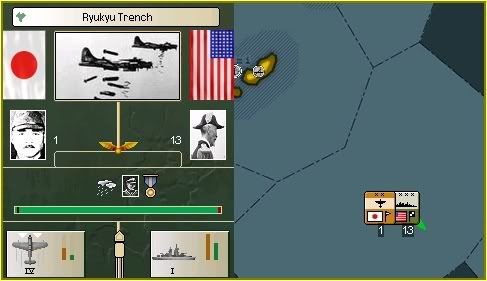
He received news of the latest position of Admiral reeves shortly afterwards. Ozawa would no doubt be delighted to learn that the Admiral had strayed close enough to the Marianas to receive some visitors.
They are German U-boats that Remble inherited from the Germans after they were annexed.germanpeon said:Also, I noticed that you are continuing to call your submarines U-Boats, even though you arent playing as Germany anymore.
Just as long as they aren't Brazilian.Nathan Madien said:Personally, I am guessing Lebanese rowboats with spitwads as ammo. We all know how vulerable the IJN is against those.
Well a solid and good update.
Can't you flank those 2 british divisions heading to Rangpur? You have 5 extra divisions nearby...
However GJ on sinking the battleship. A lot naval activity is going on. Too bad about those british carriers.
Can't you flank those 2 british divisions heading to Rangpur? You have 5 extra divisions nearby...
However GJ on sinking the battleship. A lot naval activity is going on. Too bad about those british carriers.
Maybe you could move some subs to the Indian ocean to hunt those British convoys to Burma. You should be able to spare some of Germany's U-boats and if you can get away with it for long enough you'll really hurt the British war effort in the far east.
Interesting how, with Japan, the intense air and naval activity contrasts with a much slower land campaign.
Murmurandus said:Of course no mention of secret operations...

They are so secret that they aren't mentioned.
Congratulations, Remble, on sinking 2 battleships. Ozawa is definitely proving to be the angel who saves the islands time and again. Though the Allied probably refer to him as "Death from Above".
Bit of a naval stalemate it seems to me, although it is good to see more divisiosn are starting to be built.
Good updates.
Good updates.
Deus - Thank you. Counter attacking might well work but I would need my bombers to succeed and the enemy usually wins anything but overwhelming odds. The bombers are busy for the moment and are having trouble targetting what I wish in northern India.
Naval activity is almost constant and you only see what are successful battles or battles which sink ships. There are many many more where nothing gets sunk at all.
thatguy - Unfortunately the Subs are far too damaged to try and do much of anything and you will see in the next update what happens if they do find enemy ships.
UncleAlias - It is certainly a backwards sort of war. Busy none the less.
Murmurandus - As Socraates says they are too secret for now
Sokraates - Funnily enough Ozawa is not actually that good of a Naval specialist, there are better ones, he just got the high profile job
stnylan - It is developing yes. The main problem now is that the large surplus of easy to sink ships are running out and it will become more of a hide and seek game with the more powerful fleets.
Maj. von Mauser - Thanks. Stalemate is approaching yes. Ozawa will eventually sink all of their Battleships and then the IJN can rule the waves. Until the US mega Carrier fleets start showing up
Update to follow ...
Naval activity is almost constant and you only see what are successful battles or battles which sink ships. There are many many more where nothing gets sunk at all.
thatguy - Unfortunately the Subs are far too damaged to try and do much of anything and you will see in the next update what happens if they do find enemy ships.
UncleAlias - It is certainly a backwards sort of war. Busy none the less.
Murmurandus - As Socraates says they are too secret for now
Sokraates - Funnily enough Ozawa is not actually that good of a Naval specialist, there are better ones, he just got the high profile job
stnylan - It is developing yes. The main problem now is that the large surplus of easy to sink ships are running out and it will become more of a hide and seek game with the more powerful fleets.
Maj. von Mauser - Thanks. Stalemate is approaching yes. Ozawa will eventually sink all of their Battleships and then the IJN can rule the waves. Until the US mega Carrier fleets start showing up
Update to follow ...
Operation Dilemma
14
0200 February 20th 1945.
North China Army Headquarters. Jinghong, China.
British troops had entrenched themselves in Chiang Rai province in northern Siam. Higashikuni gave orders to have them attacked to allow the bombers the chance to inflict further damage on the enemy troops.
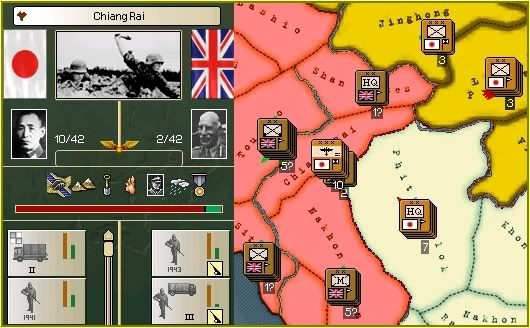
Hata led the attack by ten Japanese divisions that would last for six hours. No advance was ordered after the success of the assault.
0400 February 20th 1945.
BB Division 1 Flagship. IJN Yamashiro, Gulf of Martapan.
The former German Submarines were closing on Ceylon after months of travel and they were looking increasingly worse for wear. The situation was made far worse when one of the fleets encountered two British Destroyer Flotillas in the East Mascarene Plateau.
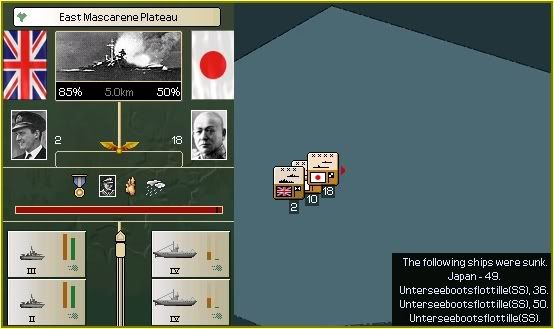
In all five U-boat Flotillas were sunk. Two had to be scuttled whilst the other three fell to the Destroyer Flotillas. This had been the single worst Naval combat for the Imperial Japanese Navy in many months.
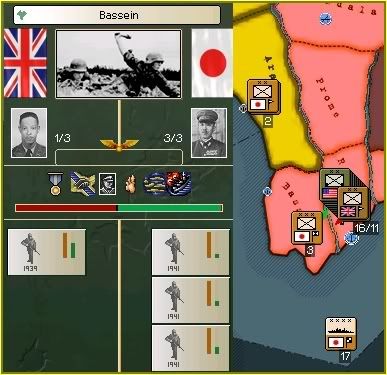
The guns of BB Division 1 were trained towards shore again when Japanese troops entered Bassein province. The small Allied counter attack failed to remove the defenders with the help of the shore bombardment.
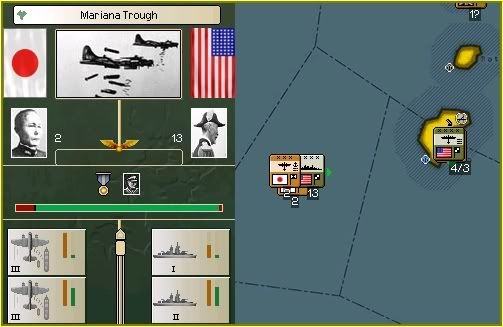
Ozawa had been tracking Admiral Reeves Battleship fleet for twenty four hours and it finally entered the Mariana Trench at 2300 hours on February 21st. The USS Arkansas was already showing signs of damage from the Naval bombers.

The Light Cruiser USS Cincinnati did not make it to the South Mariana Trench alive and by 0800 hours on the 22nd Reeves Flagship had also been sunk. The crew of the USS New York plucked the Admiral from the sea and escorted him to his new state room.

Another Transport Division failed to run BB Division 1's blockade of Rangoon and fell to the guns of IJN Yamashiro.
0700 February 23rd 1945.
North China Army Headquarters. Jinghong, China.
Advances through Burma and Siam were slow going in the hostile terrain but some progress was being made.
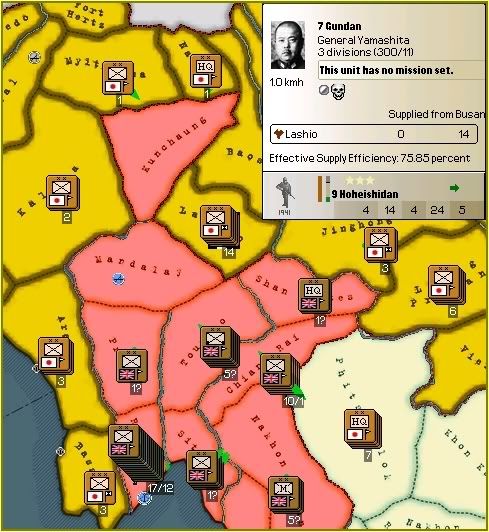
General Yamashita and the main northern Japanese force had arrived in Lashio province and easily repulsed a minor counter attack. They would require several days of rest before advancing further. Easy territorial gains were becoming harder to find and major ground combat would be required to advance much further.
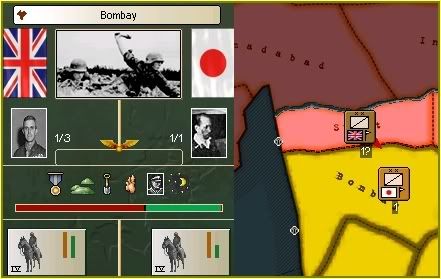
Mj. General Amano was attacked in Bombay by the enemy cavalry division that had already defeated him once. It would do so again and he would be forced to withdraw south.
1900 February 23rd 1945.
BB Division 1 Flagship. IJN Yamashiro, Gulf of Martapan.
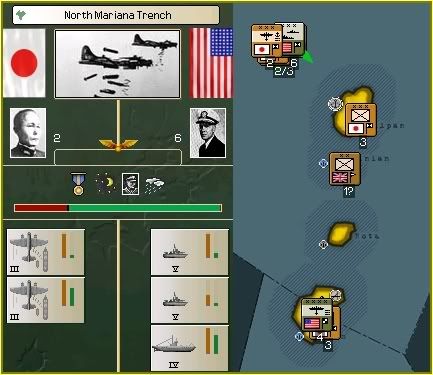
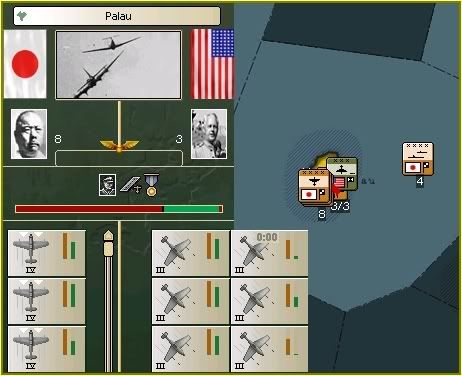
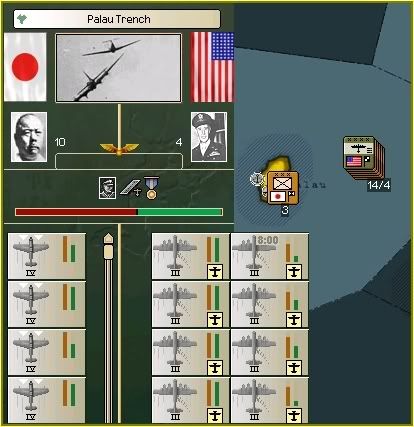
0900 February 24th 1945.
North China Army Headquarters.
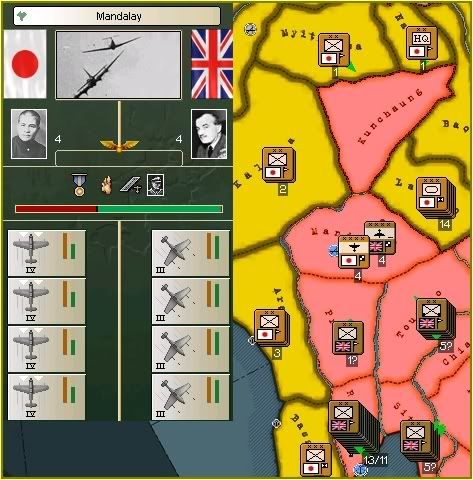
1200 February 24th 1945.
BB Division 1 Flagship. IJN Yamashiro, Gulf of Martapan.

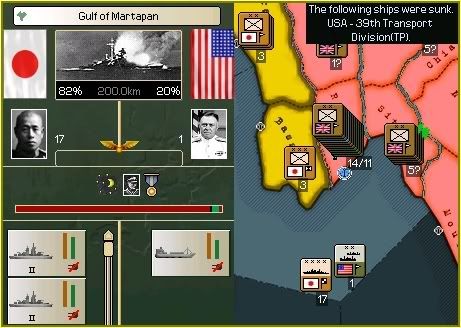
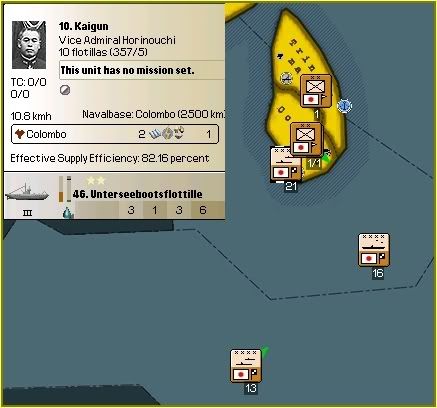
BB Division 1 Flagship. IJN Yamashiro, Gulf of Martapan.
Major enemy fleets had left the Mariana Trench for the time being which allowed Ozawa to try and sink other smaller fleets.

A Destroyer and Submarine fleet was in the North Mariana Trench and the Naval bombers amused themselves with the lighter fare until something more appropriate showed up.

Another attempt to bomb Palau was greeted with the new aircraft tactics being emplyed in the region. The three Close Air Support squadrons managed to survive the encounter with the eight Japanese interceptors but suffered badly for their troubles. Enemy Strategic bombers were stearing clear of Palau and bombing Guam and Saipan for the moment.

The interceptors found some of these bombers on February 24th as they patrolled the Mariana Trench. They inadvertantly dragged all four Naval bomber squadrons into the melee that followed, although the bombers would leave after two hours.
The American Strategic bombers suffered large losses to the six interceptor squadrons that had found them. The two interceptors that had failed to intercept this enemy flight had encountered another one to the north and suffered some damage as a result.
The American Strategic bombers suffered large losses to the six interceptor squadrons that had found them. The two interceptors that had failed to intercept this enemy flight had encountered another one to the north and suffered some damage as a result.
0900 February 24th 1945.
North China Army Headquarters.
British dive bombers had been harassing advancing Japanese troops in northern Burma and they had to be stopped before they could inflict any major damage.

Mj. General Fukui had his interceptor wing based in Imphal and found the four enemy squadrons over Mandalay as they tried to take off and head for Japanese ground concentrations. They would not be trying this again for a while.
1200 February 24th 1945.
BB Division 1 Flagship. IJN Yamashiro, Gulf of Martapan.
The French Carrier fleet had been detected close to Ceylon. Submarines were still on their way towards the island and were being given some protection by Carrier Group C.

Should the French fleet enter the Gulf of Mannar then Nagano had orders to fight it. Even in the damaged state it was in Nagano was confident that his eight Carriers could easily defeat the French. Yamamoto had ordered him not to actively pursue the enemy fleet but only to hold his position. The French fleet would by-pass Carier Group C to the south and avoid any confrontation on this occasion.

IJN Yamashiro dispatched another Transport Division that had tried to enter Rangoon. There seemed to be less and less of these ships as the days progressed which was testament to the previous months slaughter of such ships.

The arrival of a further ten Submarine Flotillas in Colombo left just thirteen at sea and they were not far from safety. They were a few hours from the protection of Carrier Group C and would make it that far. Having managed to sail half way around the World low on supplies and survive was only a part of what was needed. Japanese industry now needed to find some spare capacity to repair the very badly damaged Flotillas.
I'm getting anxious for some combat against the French. Is the plan to not advance from any Siamese territory, I'd give them something for their troubles.
Nice update, too bad about the U-Boots.
Nice update, too bad about the U-Boots.
bad buzz, you coulda done with those subs
Still, your beating seven shades outa them on the water, well transport wise, so maybe the delay in rebuilding the fleets wont be so bad...
Still, your beating seven shades outa them on the water, well transport wise, so maybe the delay in rebuilding the fleets wont be so bad...
Remble said:The Light Cruiser USS Cincinnati did not make it to the South Mariana Trench alive and by 0800 hours on the 22nd Reeves Flagship had also been sunk. The crew of the USS New York plucked the Admiral from the sea and escorted him to his new state room.
I have been wondering about these "plucking admirals out of the water" scenes. What about the rest of the crew? Do they just drown while the admiral gets the honor of half-drowing before getting plucked out? Or can I just assume that nameless crew members get rescued as well?
Nathan Madien said:I have been wondering about these "plucking admirals out of the water" scenes. What about the rest of the crew? Do they just drown while the admiral gets the honor of half-drowing before getting plucked out? Or can I just assume that nameless crew members get rescued as well?
If thats the case than I'd hate to see a destroyer that happens to be the only floating object left of a large invasion fleet that had a bit of a brush with naval bombers
Yes I can bet that the naval activity is horrendously big. Constant battles, constant watching.
Soon You'll have huge allied stack to deal with!
Soon You'll have huge allied stack to deal with!

